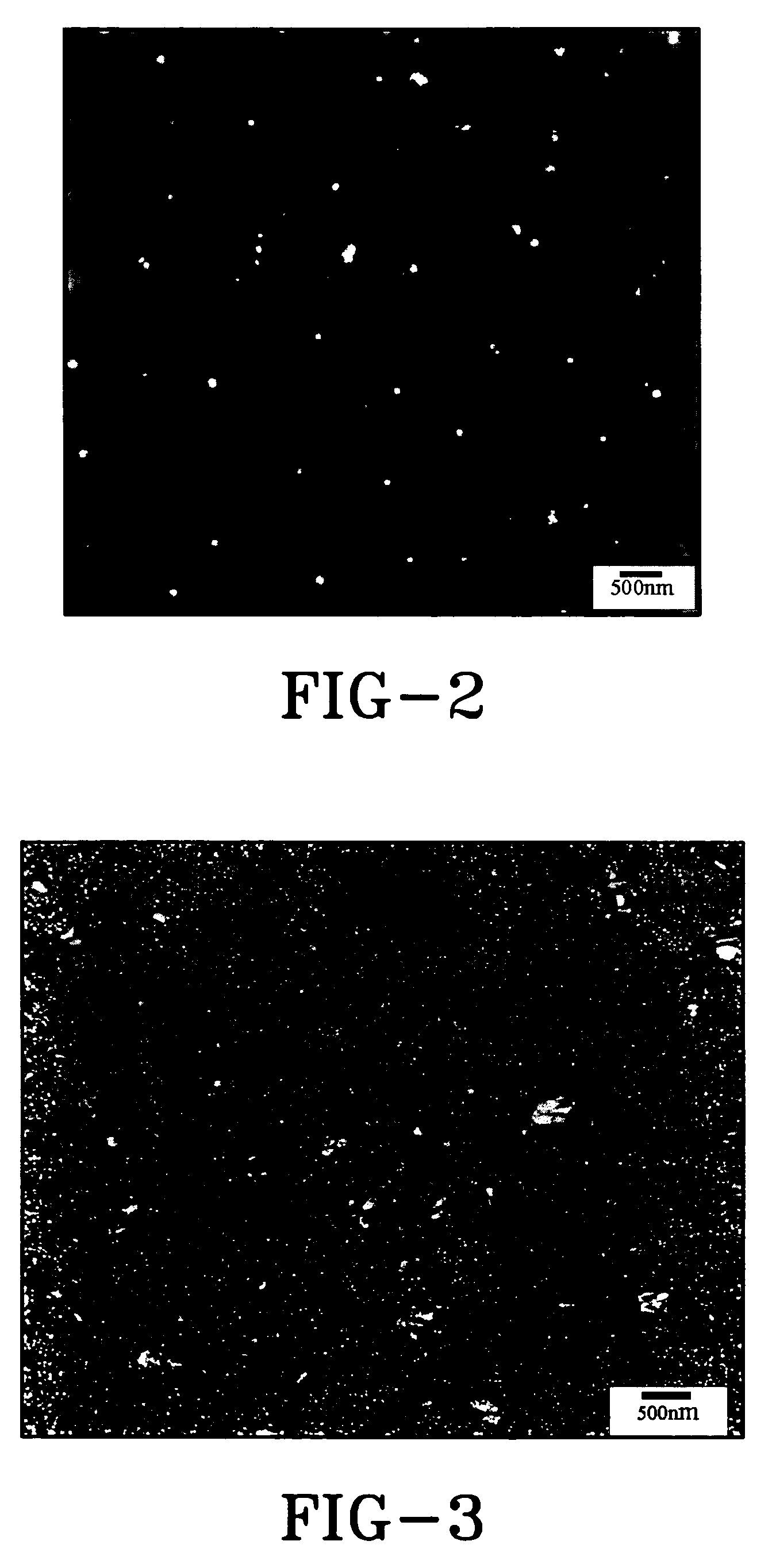Hairy polymeric nanoparticles
a polymer nanoparticle and nanoparticle technology, applied in the field of hairy polymer nanoparticles, can solve the problems of lack of dimension stability at higher service temperature above the glass transition temperature of polystyrene, affecting the performance of elastomeric polymers, and only marginally improving physical properties, etc., to achieve the effect of enhancing the properties of elastomeric polymers and higher order structur
- Summary
- Abstract
- Description
- Claims
- Application Information
AI Technical Summary
Benefits of technology
Problems solved by technology
Method used
Image
Examples
example 1
Preparation of Crosslinked Polystyrene Particle
[0048]A glass quart bottle with a rubber septum and Teflon liner was charged with a soap solution composed of 423.80 grams of reverse osmosis (RO) water, 0.58 grams of tripotassium phosphate, 65.25 grams of a 10% solution of C14-18 unsaturated fatty acid potassium salt, 5.44 grams of a 20% solution of the potassium salt of disproportionated rosin acid, 1.19 grams of a 47.5% active dispersion of sodium naphthalenesulfonate-formaldehyde. The pH of the soap solution was adjusted to 10.5-11.0 with a 20% potassium hydroxide solution.
[0049]To the bottle was added 10.13 grams of an activator solution composed of 10 grams of RO water, 0.10 grams of hydroxymethane-sulfinic acid monosodium salt dihydrate, and 0.03 grams of ethylenediaminetetraacetic acid, ferric sodium complex.
[0050]Then, 181.82 grams of styrene and 68.18 grams of 55% divinyl benzene were then added to the bottle and the mixture was purged with nitrogen gas for 3 minutes to remov...
example 2
Preparation of Polybutadiene Brushes on PS Particles
[0052]In this experiment, 50 grams of dry polystyrene cores and 500 ml hexanes were charged to a glass 1 quart (946 ml) bottle with a rubber septum and Teflon liner. The suspended solution was sonicated for 30 minutes using a 600 Watts sonicator with a 10 inch (25.4 cm) wave extender. The sonication broke apart the aggregates of polystyrene particles. The solution was then purged with nitrogen for about 30 minutes and sealed with septum.
[0053]Then, 10 ml of a 1.6 M n-butyllithium hexane solution and 1 ml of N,N,N′,N′-tetramethylethylenediamine (TMEDA) was injected through the septum. The sealed bottle was placed in a 65° C. water bath and rotated at 20 revolutions per minute for 30 minutes. The lithiated polystyrene particles showed an orange color. Butadiene in hexanes was then introduced and the bottle continued to heat in the water bath until the full conversion of butadiene was attained. The reaction was stopped by injection of...
example 3
Preparation of the Compounded Mixture
[0054]Mixing of the particle / polymer blends was accomplished in two stages. The first stage (Non-productive) involved adding half of the particle / polymer blend to a 55 cc Haake Rheomix 90 equipped with a throat, with all the temperature control zones set at 145° C., Banbury rotors, and a mixing rate of 50 rpm. After the first half of the blend is added to the mixer the other ingredients of the Non-productive are added. As soon as the Non-productive ingredients were added, the second half of the blend was added in order to clear the throat of any remaining material. The ram was lowered and the material was mixed for 6 minutes ensuring that the temperature did not exceed 170° C.
[0055]The productive mix was run under the same conditions except that the temperature zones of the mixer were controlled at 100° C. One-half of the mixed Non-productive material was added to the mixer followed by the productive ingredients, and the second half of the Non-pr...
PUM
| Property | Measurement | Unit |
|---|---|---|
| temperatures | aaaaa | aaaaa |
| mean average diameter | aaaaa | aaaaa |
| mean average diameter | aaaaa | aaaaa |
Abstract
Description
Claims
Application Information
 Login to View More
Login to View More - R&D
- Intellectual Property
- Life Sciences
- Materials
- Tech Scout
- Unparalleled Data Quality
- Higher Quality Content
- 60% Fewer Hallucinations
Browse by: Latest US Patents, China's latest patents, Technical Efficacy Thesaurus, Application Domain, Technology Topic, Popular Technical Reports.
© 2025 PatSnap. All rights reserved.Legal|Privacy policy|Modern Slavery Act Transparency Statement|Sitemap|About US| Contact US: help@patsnap.com


